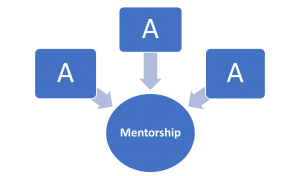How Can I Begin A Mindfulness Routine?
 Mindfulness is such a popular topic these days, but promising new research has shown how practicing mindfulness can be a powerful and effective treatment for anxiety. In a new clinical trial from Georgetown University Medical Center, mindfulness-based stress reduction (MBSR) was shown to be as effective as escitalopram (Lexapro), a commonly used antidepressant, in treating anxiety disorders in some people. Mindfulness is an effective method to bring people back to the present through breath and body awareness. It can help better regulate the body’s response to stressful, negative thoughts and rewire how a person relates to anxiety. The big question many have is: how do I get started?
Mindfulness is such a popular topic these days, but promising new research has shown how practicing mindfulness can be a powerful and effective treatment for anxiety. In a new clinical trial from Georgetown University Medical Center, mindfulness-based stress reduction (MBSR) was shown to be as effective as escitalopram (Lexapro), a commonly used antidepressant, in treating anxiety disorders in some people. Mindfulness is an effective method to bring people back to the present through breath and body awareness. It can help better regulate the body’s response to stressful, negative thoughts and rewire how a person relates to anxiety. The big question many have is: how do I get started?
Here are a few simple ways to begin a mindfulness routine:
- Pay attention to your breath: Noticing your breath is a vital starting point for any mindfulness practice. Set a timer for three minutes and turn your attention to the physical sensation of your breath (don’t manipulate or control your breathing, just focus on your normal breath). When you find yourself getting distracted, as we all do, redirect and refocus.
- Do a body scan: Body scanning is placing your attention on one body part at a time (for example, the soles of your feet) and then pausing to explore any sensations or feelings in that area. Then, shift your attention to another part of your body. Pause there and move on to another area. For a full body scan, you may want to start at your head and work your way down to your feet.
- Listen to the world around you: Mindfulness also involves turning your attention outward in addition to inward. Set a timer for five minutes and tune into the sounds around you (traffic noise, birds singing, etc). Close your eyes and hear what’s coming and going. Listen to the tone and volume.
- Take a mindfulness walk: As you walk, pay attention to the sensations of your body. How do your feet feel? Notice how your arms swing as you walk. Become more aware of your surroundings and notice the sights, sounds and smells. It’s really about opening up your senses and not walking on auto-pilot.
Distraction is normal during mindfulness, so don’t beat yourself up if you find your mind wandering during your practice. Refocusing your mind when you get distracted is the equivalent of what mindfulness practitioners call “mental pushups”. Don’t give up – with time, your ability to focus will get stronger.
Like exercise, meditation takes practice. Many of us may feel like we can’t block off a chunk of time in our already busy schedules, but even just five to ten minutes of mindfulness a day can make an enormous impact on our well-being. Are you interested in learning more about mindfulness and how it can benefit you? Leah M Joppy and Associates is ready to help. Call us at 301-670-0051 or email leah@lmja.com to learn more.
Psychological Safety
 Did you ever have an experience in the workplace that didn’t sit right with you? If so, did you feel comfortable speaking up? Perhaps you had an idea about how to improve something within your organization. Did you feel confident sharing it or did you think “why bother” and keep it to yourself? Turns out, the level of psychological safety within your office often dictates the answer to these questions and the overall culture of an organization.
Did you ever have an experience in the workplace that didn’t sit right with you? If so, did you feel comfortable speaking up? Perhaps you had an idea about how to improve something within your organization. Did you feel confident sharing it or did you think “why bother” and keep it to yourself? Turns out, the level of psychological safety within your office often dictates the answer to these questions and the overall culture of an organization.
As I mentioned in past articles, I have recently completed a certification from Cornell University on Diversity, Equity and Inclusion. The course, taught by Professor Nishii, tackles the issue of employee engagement and its three components. So far, we’ve examined psychological availability and psychological meaningfulness. This month, we’ll look at the third component: psychological safety.
What Is Psychological Safety?
Organizational psychologist William Kahn, author of the 1990 study “Physical Conditions of Personal Engagement and Disengagement at Work”, defined psychological safety as “being able to employ one’s self without fear of negative consequences to self-image, status and career”. Harvard Business School professor, Amy Edmondson, brought the idea to the masses and described it as, “a climate where people feel safe enough to take interpersonal risks by speaking up and sharing concerns, questions or ideas.” The ultimate goal is a feeling of belonging and feeling heard. And it’s something every organization should prioritize.
Why Is Psychological Safety Important?
There are few things more frustrating for team members than having an idea, suggestion or question, but not feeling able to share it or feel like anyone is listening. It not only leads to disengagement, but lowered morale, productivity and ultimately, higher turnover. On the flipside, high levels of psychological safety have shown to improve decision-making and team dynamics. When people aren’t constantly concerned about saying “the wrong thing”, organizations see greater innovation and creativity.
According to Dr. Timothy Clark in his book “The 4 Stages of Psychological Safety: Defining the Path to Inclusion and Innovation”, the stages are as follows:
- Stage 1 – Inclusion Safety: a feeling of connecting and belonging
- Stage 2 – Learner Safety: feeling safe to learn, ask questions and experiment
- Stage 3 – Contributor Safety: feeling safe to make a valuable contribution using your skills and gifts
- Stage 4 – Challenger Safety: feeling safe enough to challenge the status quo when you see an opportunity for change or improvement
How would you rate the level of psychological safety within your organization? Do team members feel comfortable sharing their ideas, questions and concerns or is there room for improvement? That’s where Leah M Joppy and Associates can step in and help. We can look at your current practices and help you craft new and innovative ways to communicate, problem-solve and engage with team members. This is particularly valuable for those who work from home and may feel more isolated and less engaged with day-to-day office life.
Let’s help create engagement in your organization via high levels of psychological safety. Call us at 301-670-0051 or email us at leah@lmja.com today.
Job Crafting: Redesigning Work
 What makes a job meaningful? Helping others? Salary or other perks? Flexibility? A sense of autonomy? The answers are as varied as the team members in your organization. What we do know is that perceiving a job as meaningful can be the difference between employees staying and contributing their best work – or moving on to greener pastures. Our last article looked at why meaningful work matters, but what steps can organizations take to make it happen? Let’s take a look at one example: job crafting. It’s not a new idea, but one that’s getting more attention since the pandemic and resulting changes in the workplace.
What makes a job meaningful? Helping others? Salary or other perks? Flexibility? A sense of autonomy? The answers are as varied as the team members in your organization. What we do know is that perceiving a job as meaningful can be the difference between employees staying and contributing their best work – or moving on to greener pastures. Our last article looked at why meaningful work matters, but what steps can organizations take to make it happen? Let’s take a look at one example: job crafting. It’s not a new idea, but one that’s getting more attention since the pandemic and resulting changes in the workplace.
What is job crafting? It’s about taking proactive steps and actions to redesign what team members do at work, essentially changing the tasks, relationships and perceptions of jobs. The main idea is that employees can stay in the same role, but get more meaning out of their jobs by simply changing what they do and the “whole point” behind it. Job crafting is creating positions that align with employees’ strengths, passions and motives.
Here’s an example: A marketing analyst spends her days examining data, researching and looking at trends. While she’s great at her job, she would really like to branch out and add some creative projects to her routine. So, she requests a meeting with the social media marketing manager at her organization to learn more about what he does and how she can incorporate her expertise to help on the creative side. Her boss works with her to help add more of these types of projects into her job.
Job crafting is broken down into three key types:
- Task Crafting: Changing responsibilities. This is altering the type, scope, sequence or number of tasks that make up a job to improve it in some way. For example, a long-time team member could offer to mentor new employees. The marketing analyst example above also uses task crafting.
- Relationship Crafting: Changing interactions. This is altering the people that employees typically interact with in a job. For example, leaders and team members can form new interdepartmental task forces.
- Cognitive Crafting: Changing mindset. This is altering the way team members interpret the tasks they’re responsible for and focusing on how their efforts help the big picture of an organization. For example, call center workers can receive first-hand accounts of the people they’re helping and how their job impacts the lives of others.
It’s no surprise that job crafting has a multitude of benefits for organizations, including happier, more engaged employees, less turnover and enhanced performance. Whether you’re interested in learning more about job crafting or other methods to help team members find more meaning in their roles, Leah M. Joppy and Associates is ready to help. Call us at 301-670-0051 or email us at leah@lmja.com and let’s start tackling any employee unengagement issues now!
Psychological Availability – How Does It Affect Your Organization?
 Most people can agree that their work life has changed dramatically over the past few years. Zoom meetings are the norm. Hybrid schedules or work-from-home jobs are becoming typical. And often, the lines between work life and home life have increasingly blurred. It has tested all of us and led to an increase in burnout and disengagement in the workplace. And that contributes to lost productivity, decreased morale and higher turnover – all things that no organization wants to deal with!
Most people can agree that their work life has changed dramatically over the past few years. Zoom meetings are the norm. Hybrid schedules or work-from-home jobs are becoming typical. And often, the lines between work life and home life have increasingly blurred. It has tested all of us and led to an increase in burnout and disengagement in the workplace. And that contributes to lost productivity, decreased morale and higher turnover – all things that no organization wants to deal with!
With all of these new challenges in mind and a desire to help organizations work through them, I am currently completing a certification from Cornell University on Diversity, Equity and Inclusion. The course, taught by Professor Nishii, takes a deep dive into the issue of employee engagement and examines three components: psychological availability, psychological meaningfulness and psychological safety. We’ll be looking at each one in more detail in the coming months, starting with psychological availability.
What Is Psychological Availability?
What exactly do we mean by the term “psychological availability”? Organizational psychologist William Kahn, the so-called father of employee engagement and author of the 1990 study “Physical Conditions of Personal Engagement and Disengagement at Work”, defined it as “employees feeling mentally and physically available to harness their full self at this particular moment.” In other words, team members should feel the demands of their position are reasonable and achievable. Work/life balance falls under this umbrella and we all know what a challenge that can be these days. “Burnout” is a term we hear all the time and are probably facing within our own organizations.
This “availability” concept includes many aspects of the workplace. For example, the physical environment has to be examined. Do employees have the equipment necessary to do their job? Do they have the space they need to work individually and as a group? Management and peer support also play a key role. Is management communicating effectively and consistently? Is the organization’s culture enabling team members to feel like they’re flourishing and not floundering? The goal of promoting psychological availability comes down to creating a workplace where team members feel heard and supported – both through the physical and emotional environment.
According to a recent workplace study from Gallup, 51% of workers are “not engaged”, meaning they are psychologically unattached to their work or company. And many of them feel they have more options now – the “Great Resignation” has had a major impact on many organizations. With all of the challenges leaders face while navigating a post-pandemic workplace, problems with disengaged employees can sneak up quickly and snowball into major issues.
That’s where Leah M Joppy and Associates can help. We can get to the root causes of WHY team members are feeling disengaged and work with you to come up with ideas to address these problems quickly. Call us at 301-670-0051 or email us at leah@lmja.com and let’s start tackling any disengagement issues now!
Psychological Availability and Work/Life Balance
 According to Gallup research, before the pandemic, 76% of workers reported feeling burned out sometimes, while 28% of workers said they were burned out “very often” or “always” at work. With the events of the past few years, you can bet those numbers are likely trending upward.
According to Gallup research, before the pandemic, 76% of workers reported feeling burned out sometimes, while 28% of workers said they were burned out “very often” or “always” at work. With the events of the past few years, you can bet those numbers are likely trending upward.
In our last article we looked at the term “psychological availability” and how it relates to employee engagement. One of the key components of psychological availability is work/life balance, often a major issue within organizations. As many of us have experienced, a lack of work/life balance often leads to burnout. According to the World Health Organization, signs of burnout at work include people feeling:
- Depleted or exhausted
- Mentally distant from their job or negative feelings or cynicism about their job
- Reduced professional efficacy
Do any of the above sound familiar? Combating employee burnout and increasing team members’ psychological availability takes some ‘out of the box’ thinking and a commitment to real and meaningful change. Here are a few ideas to get started both in terms of physical environment and organizational culture:
- Equip managers to combat burnout: Most employees say their immediate managers matter more than upper-level leaders when it comes to well-being support. But often, managers don’t understand how to talk to their employees about their well-being. That’s where training plays an important role. Managers need to learn the skills needed to identify and alleviate employee burnout. And these managers need to feel supported by upper-level management as well.
- Make work/life balance a priority: This needs to be modeled by leaders and supported organization-wide. Work/life balance initiatives can include: monitoring workload and scheduling, allowing flexible schedules to accommodate team members’ needs, encouraging use of vacation time and incorporating wellness activities into daily office life.
- Examine the physical work environment: Design environments that are as comfortable and inviting as possible. Examine the lighting. Monitor the noise levels and ways to reduce interruptions. Provide spaces that allow team members to connect with each other without disrupting the rest of the office.
That’s just the start. There are so many areas to consider and possible ideas to implement. The key is taking those crucial first steps. When it comes to employee burnout and disengagement, it’s so important to look for solutions right away, rather than wait until productivity declines and turnover increases. Call Leah M. Joppy and Associates at 301-670-0051 or email us at leah@lmja.com and let’s start tackling any disengagement issues now!
What’s Your Vision Of Returning To Work?
 Ah, September. The promise of cooler temperatures, the kids back in school, pumpkin-spice everything and a return to routine. For some, normalcy after a busy summer is a relief. But for others, it can be a big challenge after time off and a period of rest and relaxation. This year may be particularly difficult, since many of us were able to enjoy a vacation after a few years of less (or no) travel. Now that Labor Day weekend is over and the first week of September is behind us, how do we battle the “back-to-work blues” and get back into a productive routine?
Ah, September. The promise of cooler temperatures, the kids back in school, pumpkin-spice everything and a return to routine. For some, normalcy after a busy summer is a relief. But for others, it can be a big challenge after time off and a period of rest and relaxation. This year may be particularly difficult, since many of us were able to enjoy a vacation after a few years of less (or no) travel. Now that Labor Day weekend is over and the first week of September is behind us, how do we battle the “back-to-work blues” and get back into a productive routine?
Your vision of returning to the office and the reality are probably two different things. Vacation is supposed to be rejuvenating and invigorating, but one look at an overflowing inbox can really dim your enthusiasm. And that’s completely natural. The human brain adapts pretty quickly to what is considered “normal.” For those on vacation, that can mean altered sleeping schedules, greater freedom and more food and drink. Here are a few tips to help once it’s back to business as usual:
- Ease back into a normal sleep schedule: We talk about this a lot for kids returning to school, but the same advice holds for adults too. If you were a night owl and sleeping in during your vacation, it can take some time to get back to a normal sleep/wake schedule. Start to dial back your nocturnal habits to get back to your typical bedtime. Your morning self will thank you for it!
- Start slow: For the first few days, tackle the absolutes on your to-do list and leave it at that. Trying to force motivation often backfires and can leave most people in a worse state than when they started. Tiny victories are what many need to work up to tackling larger tasks.
- Incorporate some “vacation” into your life: Did you go for daily walks in nature while away? Did you try an amazing dish you’d like to learn to cook at home? Try a new wine you loved? Experiences shouldn’t be saved just for vacation. Adding them into your home life can help you relive those fun and invigorating moments.
- Give yourself some grace: This may be the most important advice of all. Laundry may sit for an extra few days. It might take you longer to complete tasks. That’s okay. Beating yourself up over not getting back to your typical level of productivity immediately isn’t helpful.
- Talk it out: If you find yourself in a prolonged funk after vacation, talking with a coach can be incredibly beneficial. A coach can offer advice to help you beat the post-vacation blues and come back to work feeling refreshed and motivated. If you often feel unenthusiastic and lack productivity after time off, a coach can help you get to the root causes of why you’re feeling this way and work with you to overcome them.
Vacations are supposed to be a significant boost to our overall health and wellbeing. Yet, so many of us struggle with getting back into the groove of work, life and routine after returning. September doesn’t have to be the cruelest month. If you need help getting motivated after time away from the office, Leah M Joppy and Associates is ready to help. Call us at 301-670-0051 or email leah@lmja.com.
Making The Transition To Work Easier For All
 Labor Day weekend is behind us and summer is quickly becoming a memory. It’s back to business as usual, but for many, it can be challenging and downright daunting returning to a normal routine and finding motivation. And with so many workers returning to an in-person office after years of working from home, it can be even more difficult. If you lead a team, you know that September can be a challenging month coming off of vacations and the more relaxed atmosphere of summer. How can you ease your team back into office life? Here are a few tips to help:
Labor Day weekend is behind us and summer is quickly becoming a memory. It’s back to business as usual, but for many, it can be challenging and downright daunting returning to a normal routine and finding motivation. And with so many workers returning to an in-person office after years of working from home, it can be even more difficult. If you lead a team, you know that September can be a challenging month coming off of vacations and the more relaxed atmosphere of summer. How can you ease your team back into office life? Here are a few tips to help:
- Communicate often: Meeting with returning staff creates structure and allows you to catch up, review priorities and set attainable goals for the coming weeks. However, keep it light and realize that this is more about motivation than piling on tasks.
- Assign some easy-to-accomplish tasks: Create a list of simple, short-term goals for your team to get them back into the swing of things without overwhelming them. This will warm them up for the bigger projects you have planned for the future.
- Plan some team building activities: Something light and fun to look forward to can go a long way towards building motivation after the summer months.
- Lead by example: As a manager, you’re probably struggling a little too (see our previous article on ways to work through it). But you also set the tone and team members feed off your energy. Let them see that you’re excited to get back to work and maybe even share some of your post-vacation productivity tips.
It can be tough motivating a team after the slower paced, vacation-laden routine of summer, but there are a number of ways you can make the transition easier. And you don’t have to do it alone. Leah M Joppy and Associates can work with you to help boost motivation and help build a more enthusiastic, cohesive team. Don’t lose weeks of productivity due to the post-vacation blues. Call us at 301-670-0051 or email leah@lmja.com to learn how we can help.
When Managers Resign
 Here’s a startling number: more than 25 million people quit their jobs in the second half of 2021. It’s why the term “Great Resignation” was born. Of course, not all of these 25 million people were in management roles within their organization, but the “Great Resignation” has certainly impacted leadership positions. Whether managers have chosen to retire or jump ship for green pastures, when the leadership of an organization is impacted, it has a ripple effect that can last for quite a while.
Here’s a startling number: more than 25 million people quit their jobs in the second half of 2021. It’s why the term “Great Resignation” was born. Of course, not all of these 25 million people were in management roles within their organization, but the “Great Resignation” has certainly impacted leadership positions. Whether managers have chosen to retire or jump ship for green pastures, when the leadership of an organization is impacted, it has a ripple effect that can last for quite a while.
Last month, we looked at why mentorship is so vital in cultivating future leaders. But what about retaining the management team you have in place now? They say that employees don’t leave organizations, they leave their managers. But why do managers resign? What causes someone who has ascended to a leadership position to decide to leave? These are a few of the top reasons:
- They don’t have the resources they need to get their job done: Managers may lack technological tools and support, administrative assistance, flexibility in their schedule, etc.
- They don’t feel supported: Managers can often feel overloaded trying to support everyone else. But who is supporting them? Who do they turn to in times of crisis?
- They feel like they’re being micromanaged: If managers feel like they lack autonomy and their ability to lead is being stifled, it can lead to lack of engagement, doubt in their abilities, anger and stress.
- They lack the training to be as effective a leader as possible: Inadequate leadership training can lead to a host of issues for both managers and team members.
- They don’t see growth: Some managers are content to stay in their role until retirement, while others may want a different path because they are bored and don’t feel challenged.
If you’re having an issue with manager turnover or just want to get a jump on any potential issues before they become a problem, working with a coaching firm like Leah M Joppy and Associates is extremely helpful. We provide a fresh perspective and unbiased approach and work with you to identify current and potential issues. We also provide the training and support needed to make managers feel valued and ready to build a strong, more effective team. Call us at 301-670-0051 or email leah@lmja.com to learn more.
The Three “A”s of Mentorship
 According to a CNB/SurveyMonkey “Happiness Workplace Survey,” about half of workers say they have a mentor at work and having that mentor leads to a higher level of happiness in the workplace. In fact, a whopping 91% of workers who have mentors reported feeling “satisfied” with their jobs. And for those who don’t have a mentor? The numbers drop by double digits.
According to a CNB/SurveyMonkey “Happiness Workplace Survey,” about half of workers say they have a mentor at work and having that mentor leads to a higher level of happiness in the workplace. In fact, a whopping 91% of workers who have mentors reported feeling “satisfied” with their jobs. And for those who don’t have a mentor? The numbers drop by double digits.
There’s no doubt that mentorship is a powerful tool. But what are some of the traits that make a great mentor? In our last article, we looked at how a strong mentorship program can benefit an organization. Now, let’s take a deeper look at what’s involved in the mentorship process and some of the fundamentals. That starts with the three “A”s: active listening, availability and analysis.
Here’s a closer look at each:
Active Listening
Strong mentors knows when to stop talking and really listen to what the mentee is saying. They understand how to guide the conversation by asking open-ended, exploratory questions. They also offer quality feedback and often refrain from offering solutions or advice, allowing the mentee to come to their own conclusions and decisions.
Availability
Effective mentors make themselves available through both physical availability and emotional availability. Physical availability refers to scheduled sessions where the mentor offers their full attention and concentration. Emotional availability doesn’t mean a shoulder to cry on, but rather the feeling of care and investment that the mentor puts out (body language, active listening, professional conduct, etc).
Analysis
Effective mentors understand the importance of answering questions and concerns honestly and with diplomacy. In short, they don’t beat around the bush. They know how to help mentees see issues from a different perspective, even if it’s not what they want to hear. That’s why it’s so vital that mentors be up-to-date on current issues and concerns within their industry and know how to modify their analysis based on the latest data.
A great mentor should have a mentees best interest at heart and be able to give quality time and attention to the process. It’s can be a challenging role, but with the right investment and training, a mentor can go from so-so to exceptional. That’s where coaching can be an invaluable asset. Leah M Joppy and Associates can work with you to build a mentorship program within your organization that will not only increase job satisfaction, but will help cultivate a pool of future leaders. Call us at 301-670-0051 or email leah@lmja.com to learn how we can help.
Building Employees’ Skills Through Mentorship
 It’s no secret that a strong mentoring program helps separate good organizations from great organizations. Your team members are your greatest asset, but the past few years have challenged even the most engaged and productive employees. Organizations are starting to reexamine their strategies and develop innovative measures to build employees’ skills, improve engagement and cultivate a pool of future leaders. A well-developed and executed mentorship program is a highly effective tool for accomplishing these goals.
It’s no secret that a strong mentoring program helps separate good organizations from great organizations. Your team members are your greatest asset, but the past few years have challenged even the most engaged and productive employees. Organizations are starting to reexamine their strategies and develop innovative measures to build employees’ skills, improve engagement and cultivate a pool of future leaders. A well-developed and executed mentorship program is a highly effective tool for accomplishing these goals.
Here’s a look at 4 ways mentoring can benefit your organization:
- Develop new managers: It’s essential to grow your potential management pool from within rather than spend more money recruiting from the outside. Mentorship has been shown to increase team members’ confidence, knowledge base and increase the skills needed to succeed for rising managers.
- Retain your high potential employees: According to studies, your high potential employees work 21% harder than their peers and bring 91% more value to the organization. Investing in a mentoring program gives these team members the long-term support they need and encourages them to stay.
- Strengthen your organization’s culture: Committing to the development of your team members pays off with improved engagement, productivity, retention and makes employees feel like you care about their growth. And that leads to a strengthened culture that makes your organization a great place to work!
- Increase knowledge sharing: What happens when people with different ways of thinking and backgrounds come together to share ideas? Increased collaboration, which in turn can lead to increased productivity and innovation. That’s a win-win for both your team members and your organization.
All of this sounds great, but how does your organization get started or improve on what you already have? It’s a big commitment and you want to make sure you’re going to see results. An experienced coach, like Leah M Joppy and Associates, can work with you through every step of the process. We can assess what (if any) mentorship program you currently have in place, make suggestions for changes and build effective mentors that will cultivate future leaders in your organization.
A growth-centric mentorship program is an investment, but it pays off in great dividends. Employee growth inevitably leads to organization growth. Ready to get started? Leah M Joppy and Associates is ready to help. Call us at 301-670-0051 or email leah@lmja.com to learn more.